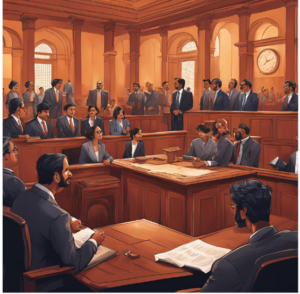 Introduction to Arbitration Laws in India
Introduction to Arbitration Laws in India
In the modern world, where societal development is rapid, the number of disputes among individuals and entities has grown exponentially. The rise in human needs has led to a corresponding increase in conflict, especially in areas like business, property, and family matters. Given the vast number of disputes, traditional litigation systems in many countries, including India, are struggling to keep pace. This overburdened judicial system, which often suffers from procedural delays and inefficiencies, has made Alternative Dispute Resolution (ADR) a necessity.
ADR refers to methods of resolving disputes outside the traditional courtroom setting. These mechanisms, which include arbitration, mediation, and conciliation, have emerged as alternatives to litigation due to their speed, cost-effectiveness, and confidentiality. Arbitration, in particular, has gained prominence as a key component of ADR systems globally and within India.
The Present Scenario of the Judicial System in India
India’s legal system, inherited from colonial rule, is under immense pressure due to its heavy caseload. As the judiciary struggles with delays and backlogs, the administration of justice becomes a bottleneck to both social and economic growth. Many cases, especially in civil matters, take years to resolve, which leads to a lack of public trust in the judicial system. The Malimath Committee (1989-90) highlighted the need for reforms to ease the judicial burden and recommended ADR mechanisms like arbitration, conciliation, and mediation.
The Need for ADR in India
The problem of delayed justice is exacerbated by a slow, cumbersome, and expensive litigation process. In some civil cases, delays have extended up to decades. In light of this situation, ADR provides an efficient alternative that helps resolve disputes without the need for prolonged litigation. Arbitration, in particular, offers a quicker resolution by involving neutral third parties to settle disputes.
In a rapidly globalizing world, the Indian legal system adoped international best practices, such as those prescribed by the United Nations Commission on International Trade Law (UNCITRAL), to manage disputes effectively. The Arbitration and Conciliation Act of 1996 serves as a major reform in this direction, harmonizing India’s legal framework with international standards.
ADR Mechanisms in India
ADR comprises several techniques that parties can use to resolve disputes without resorting to litigation. These include:
- Arbitration: Arbitration involves a neutral third party (the arbitrator) who makes a binding decision after hearing both sides. It is widely used in commercial disputes, especially in international trade. The Arbitration and Conciliation Act, 1996 governs the arbitration process in India.
- Mediation and Conciliation: Both involve third parties helping disputants reach a mutually acceptable solution. The difference is that in conciliation, the third party (conciliator) may propose solutions, whereas in mediation, the mediator helps the parties come to their own conclusion.
- Negotiation: This is a less formal approach, where parties discuss directly to reach an agreement. It is often the first step before moving to more structured ADR methods like mediation or arbitration.
- Expert Determination: In this form of ADR, an expert in the subject matter at dispute is chosen by the parties to make a final determination.
The Arbitration and Conciliation Act, 1996
The Arbitration and Conciliation Act, 1996 was a landmark reform in India’s ADR framework. It consolidated and revised the law relating to arbitration and conciliation, drawing heavily from the UNCITRAL Model Law on International Commercial Arbitration. This Act aims to reduce the scope for judicial interference in arbitration matters, thereby expediting the process. It allows parties to resolve disputes through arbitration as per an agreement without unnecessary delays.
Key provisions of the Act:
- Arbitration Agreement: The Act recognizes that parties can agree to resolve disputes through arbitration. Courts are encouraged to uphold such agreements and direct parties to arbitrate when appropriate.
- Arbitration Procedure: The Act defines the procedure for arbitration, including the appointment of arbitrators, conduct of hearings, and the rendering of awards.
- Enforcement of Foreign Awards: The Act also facilitates the recognition and enforcement of foreign arbitral awards, ensuring that India adheres to international arbitration standards. The Act provides a framework for conciliation, where a conciliator assists parties in negotiating a settlement.
Judicial Reform and ADR
India’s judiciary has faced severe strain due to the enormous backlog of cases, which undermines public confidence in the judicial system. The Malimath Committee’s recommendations, along with judicial reforms, highlight the importance of ADR to alleviate this pressure. ADR techniques like arbitration, mediation, and conciliation offer parties quicker, cheaper, and less formal alternatives to traditional litigation.
Tribunals and the Lok Adalat System
To address specific types of disputes, India has also established tribunals and Lok Adalats:
- Tribunals: These bodies specialize in resolving specific types of disputes, such as service matters, tax issues, and commercial disputes. Examples include the Income Tax Appellate Tribunal, Central Excise and Service Tax Appellate Tribunal, and Debt Recovery Tribunals.
- Lok Adalats: A unique feature of India’s ADR system, Lok Adalats aim to resolve disputes through conciliation. They have statutory recognition under the Legal Services Authorities Act, 1987, and operate at the district, state, and national levels. Lok Adalats have jurisdiction over civil, criminal, and revenue matters and focus on settlement through mutual agreement.
The Role of the Civil Procedure Code (CPC) in ADR
The Code of Civil Procedure (CPC), amended in 1999 to include Section 89, mandates the use of ADR in appropriate cases. Under Section 89, the court can refer parties to arbitration, conciliation, or mediation if both parties agree. This promotes the use of ADR in civil disputes, offering an alternative to conventional court proceedings.
The Arbitration and Conciliation Act, 1996 plays a crucial role in providing a legal framework for arbitration and conciliation, fostering a quicker and some time more cost-effective resolution of disputes.
As the ADR movement gains momentum, India is likely to see a more efficient justice system, one that can accommodate the demands of a rapidly developing society. The use of ADR should be actively promoted to ensure timely and fair justice, which is essential for the country’s continued growth and development.





